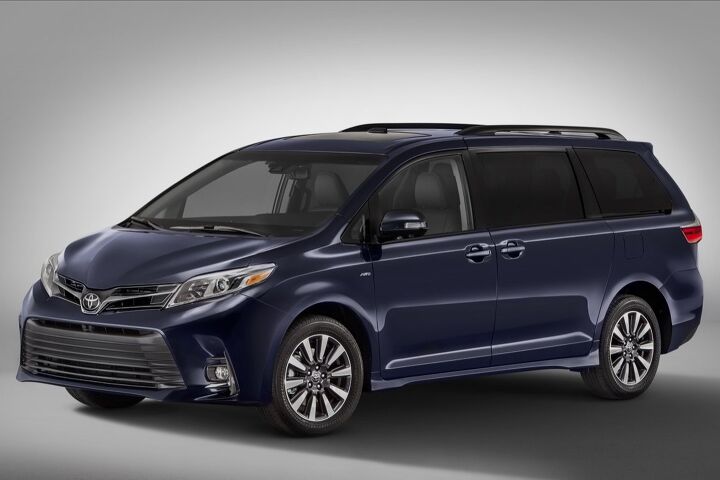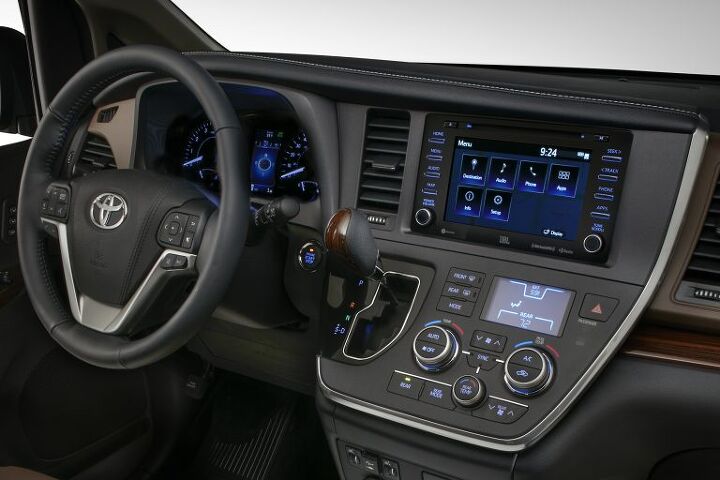All-New Toyota Sienna? Not Yet: Toyota Facelifts And Updates The Seven-Year-Old Sienna, Again
Surely it’s time for a new minivan from Toyota. Despite significant interior updates for the 2015 model year and significant powertrain improvements for 2017, the third-generation Toyota Sienna that launched in 2010 is still kickin’, seven years later.
First, the 2015 Kia Sedona shook things up. Then the 2017 Chrysler Pacifica confounded expectations. Landing shortly is the 2018 Honda Odyssey, which won’t surprise anyone if it’s the best in its class.
Clearly then, it’s your turn, Toyota.
Uh… Toyota, hello? Paging Toyota. Call for Toyota on Line 1, all-new Sienna required on the Princeton, Indiana, production line.
The 2018 Toyota Sienna gets a facelift. A refresh. An update. A refurb. What’s up with that?
The 2015 Kia Sedona, launched late in 2014, brought a new level of luxury to America’s minivan segment. Though not a dynamic tour de force, the third-generation Sedona’s interior instantly caused segment leaders from FCA, Honda, and Toyota to feel decidedly industrial.
2016 hosted the arrival of an all-new minivan from the segment progenitor: Chrysler. The 2017 Chrysler Pacific a is now the minivan of the moment; if not the best minivan purchase then still the best current minivan in which to spend time and drive.
The 2018 Honda Odyssey, meanwhile, was unveiled at the North American International Auto Show in Detroit two months ago and arrives at dealers soon. Boasting class-leading fuel economy (Pacifica Plug-in excluded), a new second-row seating arrangement, and vastly improved NVH, the new Odyssey is likely to move the game forward yet again.
Now that it’s the Sienna’s turn, Toyota is seemingly exercising a high degree of caution. Is Toyota unsure about investing too heavily in a segment in which volume has declined by nearly one-fifth over the last six months? Or was the fourth-generation Sienna sent back to the drawing board once Toyota saw how far forward the Pacifica and Odyssey leapt?
“Toyota is very committed to Sienna as it continues to be one of our core products,” Toyota spokesperson Sam Butto told TTAC this afternoon.
While declining to comment on future products, Butto says, “The current generation Sienna launched for the 2011 model year, so I would not say it is quite overdue for a next-generation launch.” Indeed, the first and second iterations of the Sienna lingered for seven model years.
We can read between the lines. “Mid-cycle enhancements, or minor changes, are very common before a next-generation launch,” Butto said, perhaps hinting at what’s to come in 2019 or 2020.
To be fair, the 2018 Toyota Sienna that will be officially unveiled at the New York International Auto Show in April is different. Toyota radically improved the third-gen Sienna’s interior already. Toyota distinctly upgraded the powertrain once, as well, making the Sienna the most powerful minivan on sale in America.
For 2018, the Sienna looks demonstrably different, inheriting a nose more akin to the 2018 Camry’s: massive, rectangular lower intake accompanied by an upper grille that squeezes a low-slung badge between two broad nostrils.
All models also receive the current Sienna SE’s side lower rockers.
But there’s no mistaking this for anything other than a third-gen Toyota Sienna, not on the outside, and not on the inside, where a new infotainment unit known as Entune 3.0 includes standard (basic) navigation.
Toyota Safety Sense-P, with pre-collision/pedestrian detection, radar cruise control, lane departure alert with steering assist, and auto high beams, is also standard on all trims for 2018. Upgrading from L to LE, SE, or XLE will bring 4G LTE capability for five mobile devices. Upgraded JBL audio is optional on the SE and XLE, Toyota says, and standard fit on the Limited. That audio upgrade brings with it upgraded navigation, as well. NVH improvements, by way of a laminated front windshield, have trickled down to the SE, though acoustic front row side glass is reserved for the Limited. There are three new colors, updated rear seat entertainment, and — scanning the press release — larger fog lights, “to convey a stronger presence.”
Yet this 2018 Sienna is the same as the 2017 Sienna, so it’s unlikely that the possession of stronger foglight presence will translate to a stronger marketplace presence. Competitors are primed to grab more market share.
Granted, the Sienna isn’t presently in a terrible place. The Toyota was America’s best-selling minivan nameplate in each of the last two years, though sales fell 28 percent through the first one-sixth of 2017, following the trend of the segment at large.
Timothy Cain is the founder of GoodCarBadCar.net, which obsesses over the free and frequent publication of U.S. and Canadian auto sales figures. Follow on Twitter @goodcarbadcar and on Facebook.
More by Timothy Cain
Latest Car Reviews
Read moreLatest Product Reviews
Read moreRecent Comments
- Redapple2 Love the wheels
- Redapple2 Good luck to them. They used to make great cars. 510. 240Z, Sentra SE-R. Maxima. Frontier.
- Joe65688619 Under Ghosn they went through the same short-term bottom-line thinking that GM did in the 80s/90s, and they have not recovered say, to their heyday in the 50s and 60s in terms of market share and innovation. Poor design decisions (a CVT in their front-wheel drive "4-Door Sports Car", model overlap in a poorly performing segment (they never needed the Altima AND the Maxima...what they needed was one vehicle with different drivetrain, including hybrid, to compete with the Accord/Camry, and decontenting their vehicles: My 2012 QX56 (I know, not a Nissan, but the same holds for the Armada) had power rear windows in the cargo area that could vent, a glass hatch on the back door that could be opened separate from the whole liftgate (in such a tall vehicle, kinda essential if you have it in a garage and want to load the trunk without having to open the garage door to make room for the lift gate), a nice driver's side folding armrest, and a few other quality-of-life details absent from my 2018 QX80. In a competitive market this attention to detai is can be the differentiator that sell cars. Now they are caught in the middle of the market, competing more with Hyundai and Kia and selling discounted vehicles near the same price points, but losing money on them. They invested also invested a lot in niche platforms. The Leaf was one of the first full EVs, but never really evolved. They misjudged the market - luxury EVs are selling, small budget models not so much. Variable compression engines offering little in terms of real-world power or tech, let a lot of complexity that is leading to higher failure rates. Aside from the Z and GT-R (low volume models), not much forced induction (whether your a fan or not, look at what Honda did with the CR-V and Acura RDX - same chassis, slap a turbo on it, make it nicer inside, and now you can sell it as a semi-premium brand with higher markup). That said, I do believe they retain the technical and engineering capability to do far better. About time management realized they need to make smarter investments and understand their markets better.
- Kwik_Shift_Pro4X Off-road fluff on vehicles that should not be off road needs to die.
- Kwik_Shift_Pro4X Saw this posted on social media; “Just bought a 2023 Tundra with the 14" screen. Let my son borrow it for the afternoon, he connected his phone to listen to his iTunes.The next day my insurance company raised my rates and added my son to my policy. The email said that a private company showed that my son drove the vehicle. He already had his own vehicle that he was insuring.My insurance company demanded he give all his insurance info and some private info for proof. He declined for privacy reasons and my insurance cancelled my policy.These new vehicles with their tech are on condition that we give up our privacy to enter their world. It's not worth it people.”



































Comments
Join the conversation
"All models also receive the current Sienna SE’s side lower rockers." I think they HAD to add the rockers to all trims just to balance out the massive revised front clip. Gluing on huge front clips like this (like they just did to the Corolla) reminds me of when GM kept "updating" the Cavalier / Sunfire by throwing on longer and longer (and uglier) front ends. This refresh makes me appreciate the conservative simplicity of the first-gen Sienna, gray bumpers and all!
Why does anyone expect a new model cycle every 6 years? If the feature set and powertrains are upgraded to remain competitive, there is no reason to completely redesign everything. The Camry has basically been the same platform since 2006, with incremental upgrades and updates over the years.